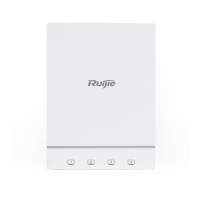Configuration Guide Configuring FAT APs
Configuring the DTIM Period
Delivery Traffic indication Map (DTIM) is a flag bit in a beacon frame, which indicates the interval at which an AP sends
broadcast frames or multicast frames. When a wireless terminal is in the sleep mode, the AP automatically caches the data
received within the DTIM interval. When the DTIM interval expires, the AP sends the cached data to the wireless terminal.
The DTIM period is a certain number of beacon frames that are sent. If the DTIM period is set to 3, the AP sends broadcast
frames or multicast frames after every three beacon frames are sent.
Configuring the U-APSD Power-Saving Mode
U-APSD is an improvement on the original power-saving mode. During association, a client can specify the triggering
attribute for some ACs, the sending attribute for some ACs, and the maximum number of packets that can be sent after
triggering. The triggering and sending attributes can also be modified when the connection admission control is used to
create a stream. After a client enters the sleep mode, packets of the ACs with the sending attribute sent to the client are
cached in the sending cache queue. The client needs to send packets of the ACs with the triggering attribute to obtain
packets in the sending cache queue. After receiving triggering packets, the AP sends the packets in the sending queue
based on the number of sending packets determined during access. The ACs without the sending attribute still use the
conventional modes defined in 802.11 for storage and transmission.
Configuring A-MPDU Aggregation
The 802.11n standard uses the A-MPDU aggregation frame format. One A-MPDU frame is aggregated from multiple MPDU
frames, in which only one PHY header is retained while all the other PHY headers are deleted. In this way, the A-MPDU
frame format reduces the additional information in PHY headers of each MPDU to be transmitted, as well as the number of
ACK frames, thus reducing the load on the protocol and effectively improving the network throughput.
Transmission Standards
802.11 is an industrial standard defined by IEEE for WLAN communication. With continuous supplementation and
improvement of this standard, the 802.11X standard series are derived. The standard series comprise 802.11b\a\g\n, which
are described as follows:
1. 802.11b
This standard operates at the 2.4 GHz band, provides the highest data transmission rate of 11 Mbit/s, or reduces the
transmission rate to 5.5, 2, or 1 Mbit/s as required.
2. 802.11a
This standard operates at the 5 GHz band, provides the highest data transmission rate of 54 Mbit/s, or reduces the
transmission rate to 48, 36, 24, 18, 12, 9 or 6 Mbit/s as required.
3. 802.11g
This standard operates at the 2.4 GHz band, provides the highest data transmission rate of 54 Mbit/s, or reduces the
transmission rate to 48, 36, 24, 18, 12, 9 or 6 Mbit/s as required. Devices supporting 802.11g are backward-compatible with
802.11b.
4. 802.11n

